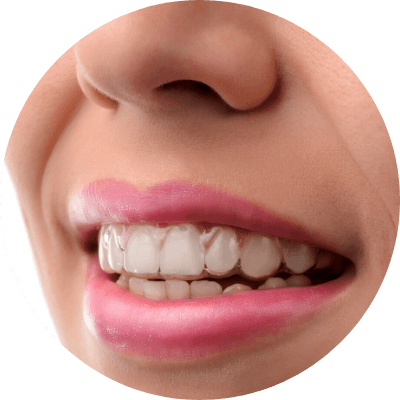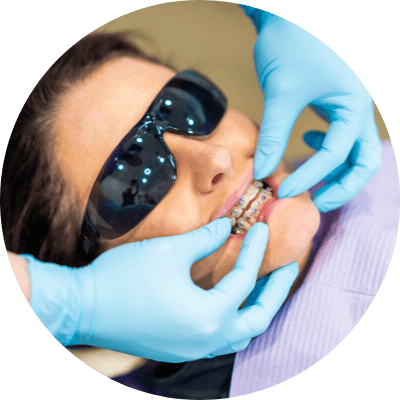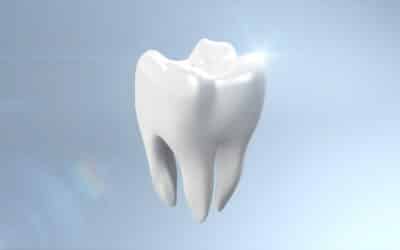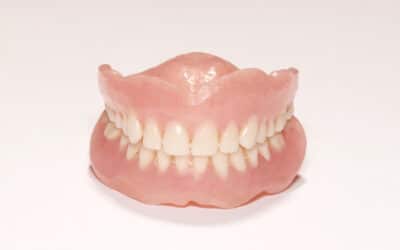Braces After 50: Getting the Right Bite
Braces After 50: Getting the Right Bite

It’s difficult to know which is better: having braces in your teens, or braces in middle age.
Just a few decades ago, in middle age they’d be to hold up your pants. Nobody much over the age of sixteen went to an orthodontist, unless it was to chauffeur someone to their appointment or settle a bill.
In your teens your parents pay (bonus) and at least a few of your friends are in the same boat.
In your 50s and beyond, unless inheritance pays, your parents won’t, and to have friends doing the same is a lot less unusual than it once was. Soon, someone will be doing invisible braces parties a-la ‘Tupperware for teeth’, where bite tray impressions are collected and cooed over before canapés and cocktails. Whoever can say ‘polyvinylsiloxane’ after their second espresso martini gets a dental deep clean voucher (valid for six months) and the creator of the most impressive (heh) 2-minute dental putty pet wins a professional 3D scan.
Such are the significant changes in orthodontics, its demographic and demands. With adults now making up a larger proportion of the orthodontic patient population has come an almost adolescent insistence for aesthetically pleasing appliances.
And like Sub-Zero Wolf freezer drawers, or a Venus Espresso machine, the chosen solution is always the confidence boosting one.
Clear brackets and clear aligners have been about the only options for the significant number of older patients completely uncomfortable with anything visible on their teeth.
And for some, the severity of their malocclusion excludes having clear aligners.
Still others are committed musicians or sports players where labial appliances are too obtrusive. When the choice is the awkward decider between personal embarrassment and less-than-optimal dental brace type, people will often avoid treatment altogether.
Sometimes it’s having disposable income and the confidence that goes with achieving better oral health, that has older people opt for dental adjustment. Sometimes their teeth have always been that way and they’d like them not to be; sometimes it’s due to tooth movement from lost teeth, trauma or disease.
Face it. Now there are few age limits to being a ‘brace face’. A familiar name in the 1970s, it was for kids with stainless steel tracks that brought teeth in, out, over or around with the precision of a well managed train station, frequented over about two years.
Now there are choices beyond traditional wire and metal: ceramic, lingual, invisible, and self-ligating.
Self-ligating braces are not new, and have been around since the 1990s. The recent increase in popularity is due to the fewer orthodontic visits required, lack of friction on the teeth, and the ease of cleaning. Similar to traditional braces in terms of installation, self-litigating bands don’t have elastics or metal bands. Instead, they rely on brackets on a clip system that allows the wires to be adjusted.
The two types of self-ligating braces are ‘active’ and ‘passive’.
Active uses thicker wire, for additional force. The passive form, and the most common, has a smaller arch wire, which reduces friction while still allowing teeth to move. Hygiene is easier than some other dental brace equipment, and because of the simpler wire insertion and removal, significantly less time is spent in the orthodontist’s chair.
Made of smaller components than traditional braces and with a choice of clear, ceramic or metal brackets, they hold general appeal; prevailingly so for older patients. Designed as a less conspicuous system, they’re kind of a best-of-both hybrid in that they maintain the efficiency of traditional style of orthodontics – that earned that longevity because they work.

As it is, teeth sustain a pressure load during the straightening procedure, so it’s important to avoid any hard biting or grinding because of that extra wear and tear on teeth already dealing with ‘extra’. Orthodontists certainly have ways of preventing either of these habits continuing should they be, or become, an issue.
Having braces makes your teeth already brace themselves. No need for a crash landing.
In the world of accelerated orthodontics, alongside whichever braces are chosen, older patients often benefit from micro-osteoperforations (MOPs). It’s a technology that makes pinholes in the bone around the teeth, which encourages a natural inflammatory response. It’s a fast and minimally uncomfortable procedure that releases cells that breakdown bone, stimulating bone regrowth which in turn accelerates tooth movement.
With the underlying hard tissue of the alveolar bone and the soft gum tissue and periodontal membrane anchoring and supporting teeth, the biggest influence on the duration of an orthodontic treatment, is the bone tissue replacement rate.
When orthodontic appliances exert a gentle, steady and prolonged pressure, teeth get a little loose. The bone breaks down, reabsorbs and rebuilds – a process known as ‘remodeling’.
Essentially, it’s a process of inflammation.
As bone remodels, teeth are able to move, and new bone fills the space they once were. Eventually, the alveolar bone completely regenerates with teeth anchored to their new position.
A study published in the American Journal of Orthodontics and Dentofacial Orthopedics found that MOPs more than doubled the rate of tooth movement and had up to a 62% reduction over the treatment timeline.
With speed often comes force, and providing more force than traditional braces, power chain braces offer another choice.
Power chains are connected strings of elastics that connect brackets to one another and form a continuous band across your teeth. Most often suggested for closing gaps, they, like all braces can also correct crooked and misaligned teeth.
The option of not being visible, rather than being invisible, belongs to lingual braces.
As an older technique, similar to traditional braces and also made of metal, lingual orthodontics attach to the inside, rather than the outside of the teeth. Originally conceived in the 1990s, the system was grandfathered by the larger orthodontic community when patients found they had speech difficulties with the bulky the brackets and irritating, direct contact with the tongue.
Issues that technical design at the time, couldn’t successfully overcome.
What makes the new generation of lingual appliances effective is each patient having computer generated, customised base and bracket sets with precision arch wires, and a specific malocclusion prescription. Although requiring more chair time, the result is a sleek, vastly improved orthodontic, comfortable for the patient with a much easier technique for the clinician.
Clear aligner systems have been adopted by many, with preplanned treatment stages.
Best suited for simpler adjustments, these removable and replacement orthodontics have aesthetics, good anchorage control and easy oral hygiene protocols.
Understanding the different dental brace systems available is not the same as being open to the expert advice of your dentist and your orthodontist. Their acquired knowledge, combined with skill and experience relative to your specific dental needs, is the best way to choose your best outcome.
Get that straight.
Note: All content and media on the Sunbury Dental House website and social media channels are created and published online for informational purposes only. It is not intended to be a substitute for professional medical advice and should not be relied on as health or personal advice.
Services Mentioned
Related Articles
Is Painless Dentistry Without Needles Possible?
Intravenous sedation is much more full on in terms of heavily sedating the patient. It is usually reserved for those having extensive…
What’s With Teeth Terms? Mulberry Molars? Flux? Butterfly? Cauliflower? Tombstone?
It’s often supposed that the roots of English are predominantly Greek and Latin. Understandably so. Words are assimilated into the language from other dialects as well, like French and Arabic. From the approximately 170,000 English words currently in use,...
Your Tooth Bone’s Connected To Your Knee Bone …
Dem bones dem bones dem dry bones … 1928 marked the first recording of that spiritual song, written by two African-American brothers James Walden and J. Rosomond Johnson. Born in 1871, James Walden Johnson was a skilled writer, distinguished lawyer, diplomat and civil...
What If You Could 3-D Print Dentures?
3-D printing is taking the world by storm. What if you could 3-D print dentures? Well, you can, and clever people are already doing it. In 2021, an article in a leading Perth newspaper featured a story on this very topic and claimed a local dentist as the sole...
















